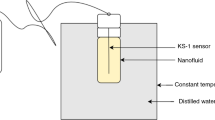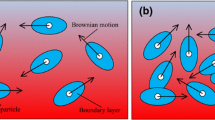Abstract
Nanoparticles suspended in a base fluid yield increased thermal conductivity, which in turn increases convection heat transfer rate. Prediction of suitable relations for determination of thermal conductivity results in heightened accuracy in the calculation of convection heat transfer coefficient and reduced costs. In the majority of studies performed on the prediction of thermal conductivity, some relations and models were used in which the effect of aggregation of particles, especially at low concentrations was ignored. In this research, the thermal conductivity of the nanofluid is measured experimentally at low volumetric concentrations, within the range of 0.02–0.2% for the nanoparticles of Al2O3, MgO, CuO, and SiC in the base fluid of distilled water. The results obtained from the models are compared by the available models considering and neglecting the effect of aggregation of particles. Within the range of the applied concentrations, the relative absolute average deviation ratio of the thermal conductivity models without considering the aggregation effect in relation with the models considering the aggregate, is observed to be between 2 and 6 times. Therefore, it is recommended that even at low concentrations, the effect of aggregation should be considered in the prediction of thermal conductivity.







Similar content being viewed by others
Abbreviations
- C p :
-
Specific heat, J/kg K
- d f :
-
Fractal dimension
- k :
-
Thermal conductivity, W/m K
- k B :
-
Stefan-Boltzmann constant, J/K
- Mf :
-
Molecular weight of base fluid, kg/kmol
- n(r cl ) :
-
Radius distribution function
- NA :
-
Avogadro constant
- r :
-
Mean radius, m
- T :
-
Temperature, K
- DLA:
-
Diffusion limited aggregation
- DLS:
-
Dynamic light scattering
- MG:
-
Maxwell-Granett
- RAAD:
-
Relative absolute average deviation
- ρ :
-
Density, kg/m3
- φ :
-
Volume fraction
- φ m :
-
Volume fraction of densely packed
- η :
-
Viscosity, Pa s
- δ :
-
Nanolayer thickness, m
- σ:
-
Standard deviation
- cl:
-
Cluster
- eff:
-
Effective
- f:
-
Base fluid
- H:
-
Hydrodynamic
- l:
-
Interfacial layer
- p:
-
Nanoparticle
- rel:
-
Relative
References
Choi SUS, Eastman JA (1995) Enhancing thermal conductivity of fluids with nanoparticles, in: Siginer DA, Wang HP developments applications of non-Newtonian flows. ASME 231:99–105
Wen D, Ding Y (2004) Experimental investigation in to convective heat transfer of nanofluids at the entrance region under laminar flow conditions. Int J Heat Mass Transf 47:5181–5188
Xuan Y, Li Q (2004) Flow and heat transfer performances of nanofluids inside small hydraulic diameter flat tube. J Eng Thermophys 25:305–307
Yang Y, Zhang Z, Brooke BA, Anderson WB, Wu CF (2005) Heat transfer properties of nanoparticles-in-fluid dispersions (nanofluids) in laminar flow. Int J Heat Mass Transf 48:1106–1116
He Y, Jin Y, Chen H, Ding Y, Cang D, Lu H (2007) Heat transfer and flow behavior of aqueous suspensions of TiO2 nanoparticles (nanofluids) flowing upward though a vertical pipe. Int J Heat Mass Transf 50:2272–2281
Duangthongsuk W, Wongwises S (2009) Heat transfer enhancement and pressure drop characteristics of TiO2-water nanofluids in a double-tube counter flow heat exchanger. Int J Heat Mass Transf 52:2059–2067
Hwang KS, Jang SP, Choi SUS (2009) Flow and convective heat transfer characteristics of water-based Al2O3nanofluids in fully developed laminar flow regime. Int J Heat Mass Transf 52:193–199
Sundar LS, Sharma KV (2010) Heat transfer enhancements of low volume concentration Al2O3 nanofluid and with longitudinal strips in a circular tube. Int J Heat Mass Transf 53:4280–4286
Sajadi AR, Kazemi MH (2011) Investigation of turbulent convective heat transfer and pressure drop of TiO2/water nanofluid in circular tube. Int Commun Heat Mass Transf 38:1474–1478
Sundar LS, Naik MT, Sharma KV, Singh MK, Reddy TCS (2012) Experimental investigation of forced convection heat transfer and friction factor in a tube with Fe3O4 magnetic nanofluid. Exp Thermal Fluid Sci 37:65–71
Djajadiwanta E, Al-Ansary HA, Al-Dakkan K, Bagabas A, Al-Jakiwi A, Zedan MF (2011) Turbulent convective heat transfer and pressure drop of dilute CuO-water, 3rd micro and Nano flows conference Thessaloniki, Greece
Pak BC, Cho YI (1998) Hydrodynamic and heat transfer study of dispersed fluids with submicron metallic oxide particles. Exp Heat Transf A 11:151–170
Qiang L, Yimin X (2002) Convective heat transfer and flow characteristics of cu -water nanofluid. Sci China (Ser E) Technol Sci 45:408–416
Duangthongsuk W, Wongwises S (2010) An experimental study on the heat transfer performance and pressure drop of TiO2-water nanofluids flowing under a turbulent flow regime. Int J Heat Transf 53:333–344
Asirvatham LG, Raja B, Lal DM, Wongwises S (2011) Convective heat transfer of nanofluids with correlations. Particulogy 9:626–631
Vishwanadula H, Nsofor EC (2012) Studies on forced convection nanofluid flow in circular conditions. ARPN J Eng Appl Sci 7:371–376
Kanna PR, Taler J, Anbumalar V, Kumar AVS, Pushparaj A, Christopher DS (2015) Conjugate heat transfer from sudden expansion using nanofluid. Numer Heat Transf A 67:75–99
Wang X-Q, Mujumdar S (2008) A review on nanofluids - part I: theoretical and numerical investigations. Braz J Chem Eng 25:613–630
Duangthongsuk W, Wongwises S (2008) Effect of thermophysical properties models on the predicting of the convective heat transfer coefficient for low concentration nanofluid. Int Commun Heat Mass Transf 35:1320–1326
Motevasel M, Soleimanynazar A, Jamialahmadi M (2014) Comparing mathematical models to calculate the thermal conductivity of nanofluids. Am J Oil Chem Technol 2:359–369
Murshed SMS, Leong KC, Yang C (2005) Enhanced thermal conductivity of TiO2-water nanofluids. Int J Therm Sci 44:367–373
Xuan Y, Li Q (2000) Heat transfer enhancement of nanofluids. Int J Heat Fluid Flow 21:58–64
Gaganpreet SS (2012) Effect of aggregation on thermal conductivity and viscosity of Nanofluids. Appl Nanosci 2:325–331
Wen D, Ding X (2005) Formulation of nanofluids for natural convective heat transfer applications. Int J Heat and Fluid Flow 26:855–864
Maxwell-Granett JC (1904) Colours in metal glasses and in metallic films. Philos Trans Roy Soc A 203:385–420
Xuan Y, Li Q, Hu W (2003) Aggregation structure and thermal conductivity of nanofluids. AICHE J 49:1038–1043
Wang BX, Zhou LP, Peng XF (2003) A fractal model for predicting the effective thermal conductivity of liquid with suspension of nanoparticles. Int J Heat Mass Transf 46:2665–2672
Xie H, Fujii M, Zhang X (2005) Effect of interfacial nanolayer on the effective thermal conductivity of nanoparticle-fluid mixture. Int J Heat Mass Transf 48:2926–2932
Venerus DC, Jiang Y (2011) Investigation of thermal transport in colloidal silica dispersions (nanofluids). J Nanopart Res 13:3075–3083
Tao W, Ni MJ, Luo ZY, Shou CH, Cen KF (2012) Viscosity and aggregation structure of nanocolloidal dispersions. Chinese Sci Bull 57:3644–3651
Kok CM, Rudin A (1981) Relationship between hydrodynamic radius and the radius of gyration of a polymer in solution. Makromol Chem Rapid Commun 2:655–659
Rooij RD, Potanin AA, Ende D, Mellema J (1993) Steady shear viscosity of weakly aggregating polystyrene latex dispersions. J Chem Phys 99:9213–9223
Chylek P, Srivastava V (1983) Dielectric constant of composite in homogeneous medium. Phys Rev B 27:5098–5106
Thomas JC (1987) The determination of log normal particle size distribution by dynamic light scattering. J Colloid Interface Sci 117:187–192
Bruggeman DAG (1935) Berechnung verschiedener physikalischer konstanten von heterogenen substanzen. I dielektrizitatskonstanten und leitfahigkeiten der mischkorperaus Isotropen substanzen Annalen der Physik Leipzig 24:639–679
Hui PM, Stroud D (1986) Complex dielectric response of metal-particle clusters. Phys Rev B 33:2163–2169
Hui PM, Stroud D (1994) Effective linear and nonlinear response of fractal clusters. Phys Rev B 49:2163–2169
Yu W, Choi SUS (2003) The role of interfacial layers in the enhanced thermal conductivity of nanofluids, a renovated Maxwell model. J Nanopart Res 5:167–171
Dwornick BL, Jeyashekar NS, Johnson JE, Schall JD, Comfort AS, Zou Q, Dusenbury JS, Thrush SJ, Powers CC, Hutzler SA, Frame EA (2012) Application of dynamic light scattering to characterize nanoparticle agglomeration in alumina nanofluids and its effect on thermal conductivity. U.S. Army TARDEC report, 23101
Özerinç S, Kakaç S, Yaziciğlu AG (2010) Enhanced thermal conductivity of nanofluids, a state of the art review. Microfluid Nanofluid 8:145–170
Acknowledgements
The authors would like to express their appreciation to the Petroleum University of Technology (PUT) for providing financial support for this study.
Author information
Authors and Affiliations
Corresponding author
Ethics declarations
Conflict of interest statement
On behalf of all authors, the corresponding author states that there is no conflict of interest.
Rights and permissions
About this article
Cite this article
Motevasel, M., Nazar, A.R.S. & Jamialahmadi, M. The effect of nanoparticles aggregation on the thermal conductivity of nanofluids at very low concentrations: Experimental and theoretical evaluations. Heat Mass Transfer 54, 125–133 (2018). https://doi.org/10.1007/s00231-017-2116-2
Received:
Accepted:
Published:
Issue Date:
DOI: https://doi.org/10.1007/s00231-017-2116-2




